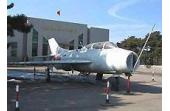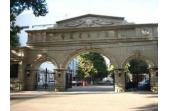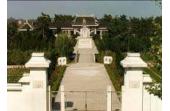Commemorative Museum Of The War To Resist U.s. Aggression And Aid North Korea
- Things to do
-
- Photo(10)
- Tips&article(3)
- Make it Happen
- Map
-
loading...
Address:
Jinjiang Mountain Avenue NO.68, Dandong City
Feature:
It is the one and only theme commemorative museum in China where the War to resist U.S. Aggression and Aid North Korea is introduced comprehensively.
Overview:
The museum was built in 1958 and its name was inscribed by Guo Moruo (a famed Chinese writer and poet). On July 27, 1993, on the 40th anniversary of the signing of the North Korea Armistice Agreement, the new museum was opened officially and Hu Jintao cut the ribbon at the opening ceremony.
The museum possesses more than 20,000 cultural relics, which are separated into two series, namely, the relics of the war and the historical relics. The relics of the war are about 12, 000 in total, among which 47 pieces are national cultural relics of first grade. There is the first class independence medal of Hong Xuezhi (the original deputy commander of the voluntary army), investigation materials of the roads to the north of Pyongyang, investigation pictures of the transportation in North Korea, the camera used by Jie Fang (the chief of staff of the voluntary army) during the negotiations, the first class national flag medal and independence medal of Li Zhimin (the political commissar of the 19th regiment), the first class national flag medal of Yang Dezhi (the commander of the 19th regiment), the carbine of Song Shilun (the commander of the 9th regiment), and the script of the "Days and Nights on the South Bank of Han River" written by Wei Wei.
The museum is the complex of the Chinese traditional style and modern architectural features. It consists of the exhibition hall, the Panoramic Painting Gallery and the Memorial Tower. The Outdoor Weapons Exhibition Park also contains exhibits about the War to Resist U.S. Aggression and Aid North Korea.
The lobby is right in the center of the hall. Carved with relief sculptures as a background, the giant sculptures of Mao Zedong and Peng Dehuai stand in the middle. Campaign songs and Mao Zedong’s commands to organize the Chinese People’s Voluntary Army are carved on both sides of the two giant sculptures. There are 10 exhibition halls, where over 500 photos and 1,000 cultural relics are displayed. Equipped with modern exhibition facilities, the museum shows the history of the war vividly.
Panoramic Painting Gallery is 28.4 meters high with the diameter of 46 meters. It is separated into two floors. The upper floor is the exhibition hall of panoramic paintings, while the lower floor is the hall for the air force. A panoramic painting named “Battle by the Qingchuan River” is displayed in the Panoramic Painting Gallery.
It was painted under the background of the second battle of the War to Resist U.S. Aggression and Aid North Korea, and focused on the battles involving Sansuo Li, Longyuan Li and Songgu Mountain by the Qingchuan River. It well reflects the heroism of the voluntary armies. It is 16 meters high with the perimeter of 132.
6 meters, reproducing the scene of the battles artistically.
Memorial Tower consists of groups of houses as well as the tower as its main section. With a height of 53 meters, the tower symbolizes the victory of the War to Resist U.S. Aggression and Aid North Korea and the declaration of the armistice agreement in 1953. The front side of the tower is carved with seven gilding characters "抗美援朝纪念塔" (the Memorial Tower of the war) written by Deng Xiaoping. On the back, there is an inscription recording the achievements of the voluntary armies.
Outdoor Weapon Exhibition Park covers an area of 2,000 square meters. What are displayed are the heavy weapons once used during the war to resist U.S. Aggression and Aid North Korea. There are planes, cannons, tanks and other equipment. Moreover, the heavy weapons captured by voluntary armies are also exhibited.
Transportation:
You can take the bus NO.1, 3, 4, 5, 21, 22 and 23 in the downtown of Dandong City.
Tips & articles
|
|
|












